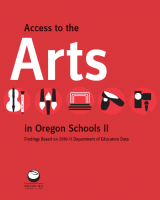Access to the Arts in Oregon Schools II
GENERAL
Arts education plays a critical role in preparing students for life beyond graduation and developing 21st century skills. To achieve Governor John Kitzhaber’s 40-40-20 educational attainment goal (40% of Oregonians obtain a Bachelor’s Degree, 40% obtain an Associate’s Degree or post-secondary credential and 20% obtain a high school diploma or equivalent), students will need a well rounded education—one that weaves core subjects with the arts. Our students must experience quality arts instruction provided by both certified educators and skilled teaching artists.
This report’s key findings indicate that is not the case for many Oregon students. A lack of stability in classes offered by schools from year to year means many students are robbed of the benefits of arts education—improved academic achievement, greater leadership and social skills, enhanced critical thinking and sharper problem-solving skills.
The good news? Increasingly, important decisions are made on the local level. This means the power to change access to arts education rests locally as well. In order to inform local discussions, and using information from the Oregon Department of Education, the Oregon Arts Commission has developed an online database with the information contained in this report. Oregonians can now search by school building or school district and see what arts disciplines are taught by a certified art teacher at their schools: www.oregonartscommission.org/programs/arts-learning
This data only tells one piece of the story: it relates to standalone arts classes taught by certified teachers. It does not begin to discuss the many residencies, arts integration efforts or community arts experiences that contribute to a robust, thoughtful, comprehensive arts education. There is still much to be learned about the status of the arts in our schools. In a complex ecosystem, how can we as a state join together to measure how our students are developing their creative thinking skills?
The Oregon Arts Commission is committed to continuing the conversation: in developing budget and program plans that work to achieve Oregon’s high level outcomes for education; with Dr. Rudy Crew and the Oregon Education Investment Board; in convening practitioners and advocates; by populating the online database and using reports like this one and its companion: “Connections: Arts Learning in Oregon,” to tell the stories behind the data. The National Association of Music Parents reports that “79% of Americans agree that incorporating the arts into education is the first step in adding back what’s missing in public education today.”
A creative education gives students a head start towards achieving Oregon’s 40-40-20 goal, but it also gives them the opportunity to experience the thrill of creation, the wonder of a new question and the confidence of accomplishment.
How will Oregon, a cradle of creativity, respond? [Introduction by Christine D'Arcy, p. 2]
79% of Oregon public schools provided access to instruction in at least one discipline (1% decrease from 2009-2010.) Arts in charter schools increased 2% from 2009-2010 and access in regular public schools decreased by 1%. 71% of elementary schools provided arts instruction as part of the regular curriculum, 97% of middle schools, but 17% of Oregon high schools provided instruction in all five disciplines. 11% of students attended a school with no access to arts instruction and 40% of schools offered instruction in one discipline. Compared to the 2009-2010 report, 17% of high schools offered instruction in five disciplines, an 11% increase.
BIBLIOGRAPHY






